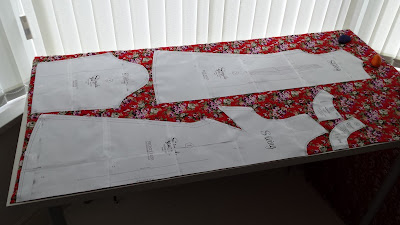PATTERN
LAYOUT AND ITS TYPE
WHAT IS PATTERN LAYOUT?
The association of styles portions onto the laid lay supposed for slicing garment components is referred to as sample format or truely format. The placement of sample at the cloth, in a cheap manner, this is with out losing cloth is referred to as sample format.
What are the rules to be keep in mind for pattern layout.
ü Press the
material earlier than laying it out at the desk.
ü A massive
desk is beneficial for readily laying out all the pattern portions.
ü For an open
format (in which single thickness of fabric is used) location the cloth with
the right aspect up.
ü For all
other layouts, fold the proper facets going through each different so that the
incorrect side faces seamstress.
ü If a
combination fold is used, lay and cut the lengthwise sample pieces first
earlier than refolding the fabric for crosswise layout.
ü due to the
fact maximum clothes are made with the lengthwise grain strolling vertically on
the body, align the sample pieces on the cloth thus, with the grainline of
pattern parallel to the selvage.
ü Pin all of
the pattern portions to the cloth. Use only dressmaker’s pins as they do now
not harm the cloth. Pins ought to be perpendicular to the sewing strains and
the reducing line.
ü place big
sample portions first and then suit inside the smaller ones.
ü Lay the
portions as close to every other so that fabric isn't always wasted.
ü in shape
sample portions which can be similar in shape next to every other. This
technique is called dovetailing.
ü continually
check out to peer if all of the sample pieces healthy into the material getting
used.
ü Mark seam
allowances at the fabric if the sample shows so.
ü If sample
details are being transferred using a carbon paper, use a paper that is as near
the color of the cloth as viable.
ü Mark sample
info handiest on the incorrect facet of the fabric.
ü maintain
the fold strains of patterns at the folded fringe of the fabric.
ü whilst
using a lining material, mark simplest on the lining than at the actual cloth
the garment is made.
ü try to fit
the wide give up of one piece to the narrower give up of the alternative. Ex:
petticoat format.
ü arrange all
pattern portions earlier than reducing the cloth.
WHAT ARE THE TYPES OF FOLD IN PATTERN LAYOUT?
There are seven types of fold in pattern layout. they are,
A. Lengthwise
fold
B. Partial
lengthwise fold
C. Double
lengthwise fold
D. Cross-wise
fold
E. Partial
cross-wise fold
F. Combinational
fold
G. Open fold
A. LENGTH WISE FOLD
· Lengthwise
fold is made on lengthwise direction with selvedge matching along one edge.
· This type
of fold most frequently used and it is convenient easy to manage.
· Sleeve
pieces are mostly cut in this method.
B. PARTIAL LENGTH WISE FOLDpartial lengthwise fold
· Partial
lengthwise fold is made of length wise direction with one selvedge placed from
a measured distance and from fold 8 balance of fabric is in single layer.
· Width of
the fold is determined by the width of the half pattern including the seam
allowances. This type of fold is used when narrow pieces have to be cut on
fold.
· Mostly
blouse pieces are cut in this method.
C. DOUBLE LENGTH WISE FOLDdouble lengthwise fold
· In double length wise fold, the selvedges meet on the centre.
· When each back and
front portions are to be reduce on a fold, This technique is used.
· It is vital to preserve the space from every fold to selvedge.
D. CROSS-WISE FOLDcrosswise fold
· Cross-wise
fold is made on cross wise direction with selvedge match’s along two edges.
· This type
is generally used to the cross-wise fold would be used for full of fabric (or)
to accommodate any unusually wide pattern pieces.
· Mostly
frock ,umbrella gown pattern are cut in this method
 |
| partial crosswise fold |
E. PARTIAL CROSS-WISE FOLD
· For a
crosswise fold, fabric is usually folded so that cut ends match. However, a
crosswise fold can also be a partial fold.
· A crosswise
fold is often used when pattern pieces are too wide to fit on fabric folded
lengthwise.
F. COMBINATIONAL FOLD
· In
combinational fold, the fabric can be folded in two different way for the
layout.
· Normally
two or more types of fold are laid together as any combination is possible.
· Lengthwise
fold or cross-wise fold may be combined; double length wise fold or double
cross-wise fold may be combined.
· In open
layout the fabric is not folded, the pattern is laid on the open width of the
fabric.
· This type
of layout is used for design which require right left cuts have to be cut
separately.
· In most
production open layout method is followed.










Comments
Post a Comment